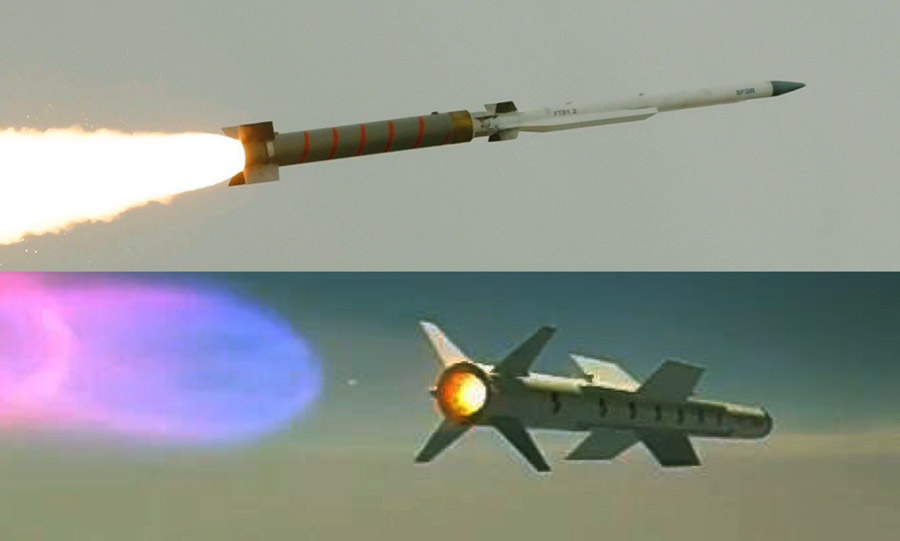
If the Indian Air Force’s unusual satisfaction and eagerness with the indigenously developed Astra air-to-air missile is any indicator, then a technology test conducted on India’s east coast last week should clear the decks for some serious joy ahead.
Last Friday the Defence Research & Development Organisation (DRDO) tested a complete solid fuel ducted ramjet (SFDR) propulsion system from a ground based launcher, blasting a missile system to a high altitude and achieving speeds in excess of Mach 3. Unlike the Astra, which rides on a smokeless solid fuel rocket motor, SFDR technology — a $70 million joint effort since 2013 by India and Russia — takes every performance aspect of the Astra to the next level, crucially range, sustained speed and kinetic energy during the difficult endgame phase when such missiles close in on normally manoeuvering targets.
The Friday test was a big step up from the debut SFDR test conducted last May when the weapon fired sported only a nozzle-less booster and not the actual ducted ramjet system (with a boron-based sustainer) that powers in later to send the missile screaming across long ranges with minimal dissipation of energy. The big plan is for the SFDR-powered missile to closely mirror the world’s currently most advanced air-to-air missile, the MBDA Meteor, a system that the Indian Air Force will operate on its Rafale fighters arriving this year, and has been hoping to deploy on other platforms too but has hit an integration roadblock.
With the Astra in a final stage of acceptance trials with the Indian Air Force before entry into service (later this year is the hope), with the SFDR technology, the DRDO will be looking to replicate a template of close ground-up coordination with the IAF, concurrent engineering and a plan that allows pilots to discover the capabilities of the missile as it’s being developed, instead of simply being saddled with a developed system at the end, with a hope and prayer that they like what they’ve got.
“The SFDR technology will be a legacy leap in our air combat weaponry,” said an Indian Air Force officer embedded with the SFDR development team, speaking to Livefist on condition of anonymity. “The Astra itself is turning out to be a very capable weapon system, even beyond some of our expectations. With SFDR, as they say, the sky is the limit. We are waiting to see what else this technology can demonstrate, especially from air launches and sustained velocity tests, which we will be gearing up for later this year.”
Last year, the Astra missile system also transitioned from a Russian-built seeker to an Indian Ku-band seeker — an enormous leap, considering India’s traditional dependence on Russia for these critical computers that actually guide missiles to their targets. This development will carry forward and be fine-tuned on the SFDR-based weapon, a crucial requirement for the higher performance weapon.
A senior DRDO scientist with the missiles and munitions cluster told Livefist, “This is a strategically very critical program with our Russian partners. The first application will be a new air-to-air missile and all current work will be dedicated towards achieving that. The IAF has been a very good partner for us on the Astra, and we are looking forward to carrying that ahead with this new technology.”
In 2016, during ground tests, the DRDO had revealed that the SFDR-powered weapon would sport a range of 120 km at speeds of 2.3-2.5 Mach, though these specifications are understood to have been revised upward now. The DRDO and Russia have worked together on the development and testing of the nozzle-less booster, boron-based ramjet sustainer and fuel flow controller, in addition to the design of the the dual air intakes. The $70 million program aims to achieve demonstrable finality by summer 2020, by which time the Indian Air Force — as with the Astra — will guide an acceptance phase. Engineering design and wind tunnel testing on the new missile is still under way and is likely to see changes as the SFDR system progresses through testing.
With SFDR tech now up and rolling, the Indian Air Force will basically get to craft its air-to-air missile payloads around three systems in the medium term: the MBDA ASRAAM for close combat heat-seeking duties, the Astra for beyond visual range and the Meteor+SFDR at the higher end. Theoretically, the SFDR weapon will be deployable across the IAF’s fleet, from the LCA Tejas to MiG-29s and Su-30s. But whether the missile will be a fit on the Rafale remains to be seen. Either way, the success of the program could potentially satiate the Indian Air Force’s need for a higher performance beyond visual range missile with fleet-wide integration.
Senior defence journalist Vishnu Som said on Twitter, “What this means is that India is on the verge of mastering game-changing missile technology which will enable a jet fighter like the Tejas to launch an air to air missile that will travel at between Mach 3 and Mach 7 towards a Chinese fighter likely upwards of 300 km away.”
Defence analyst and writer Mihir Shah says, “This is great news. It may still take a decade for a missile based on this tech to become operational, but it will provide a significant boost to our air power. SFDR + Astra + ASRAAM should make for a formidable combination.”
from Livefist http://bit.ly/2GB7pTi
via Live Defense
No comments: